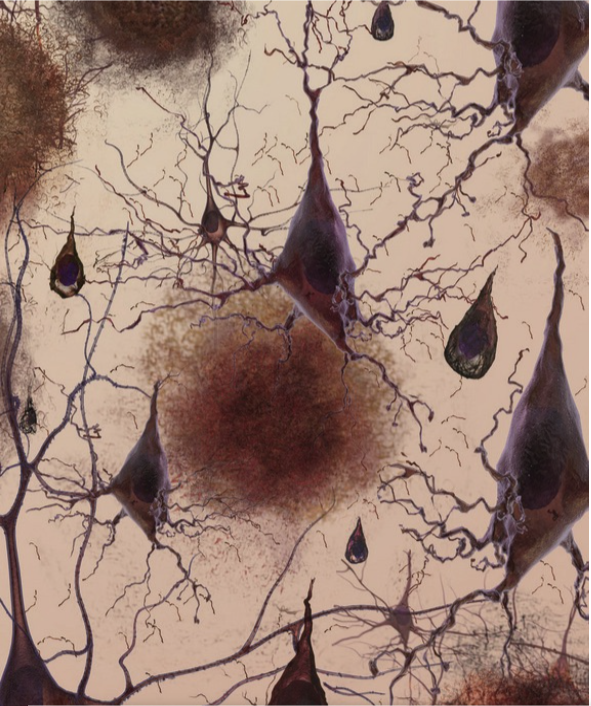
AUTHORS: Siu C, Balsor J, Jones D, Murphy K
Summary: Caitlin Siu
Myelin is typically thought of as insulation, but recent studies show it also plays roles in neuroplasticity, axonal metabolism, and neuroimmune signalling. Myelin is complex, and composed of many proteins, with Myelin Basic Protein (MBP) being the most studied. MBP has 2 families: Classic-MBP, necessary for activity-driven compaction of myelin around axons; and Golli-MBP, found in neurons, oligodendrocytes, and T-cells, called a “molecular link” between the nervous and immune systems. In visual cortex, myelin proteins interact with immune cells to affect experience-dependent plasticity. We studied myelin in human visual cortex using Western blotting to quantify Classic- and Golli-MBP expression in post-mortem samples ranging from 20 days to 80 years old. We found that Classic- and Golli-MBP have different patterns of change across the lifespan. Classic-MBP increases up to 42 years and then declines into aging. Golli-MBP has early developmental changes that coincide with milestones in visual system sensitive period, and gradually increases into aging. There are three stages in the balance between Classic- and Golli-MBP expression, with Golli-MBP dominating early, then shifting to Classic-MBP, and back to Golli-MBP in aging. Golli-MBP has a wave of high inter-individual variability during childhood. These results are timely because they complement recent advances in MRI techniques that produce high resolution maps of cortical myelin in normal and diseased brain. The pattern of Golli-MBP across the lifespan suggests it supports high neuroimmune interaction in cortical development and in aging.
CITATION: Siu CR, Balsor JL, Jones DG and Murphy KM (2015) Front Neurosci 9:138.
AREA: Sensory Systems
PHOTO CREDIT: http://www.news.ucsb.edu/sites/www.news.ucsb.edu/files/ slideshow_images/2014/Nerve%20cells.jpg

AUTHORS: Rosa E, Fahnestock M
AUTHORS: Rosa E, Fahnestock M
Summary: Elyse Rosa
Alzheimer’s disease (AD) is characterized by accumulation of extracellular amyloid-β (Aβ), which eventually leads to synaptic dysfunction, memory loss and cognitive decline. However, the toxic mechanism is not well understood. One theory suggests that amyloid-β leads to cognitive dysfunction by diminishing trophic support for affected neurons. This has been supported by findings that brain- derived neurotrophic factor (BDNF) mRNA and protein levels are significantly down-regulated in AD (Garzon, et al., 2002; Holsinger, et al., 2000; Michalski & Fahnestock 2003). Previous work has demonstrated that Aβ decreases activity-induced BDNF transcription by regulating cyclic AMP response element binding protein (CREB) activation via phosphorylation. However, the specific mechanism by which Aβ reduces basal BDNF expression remains unclear. We found that differentiated, unstimulated human neuroblastoma (SH-SY5Y) cells treated with oligomeric Aβ exhibited a significant reduction of basal BDNF expression and significantly reduced CREB mRNA compared to controls. Total CREB protein was decreased in both the cytoplasm and nucleus of Aβ-treated cells. However, neither the levels of activated CREB (pCREB133) nor inactivated CREB (pCREB129) were altered relative to total CREB levels. The PKA activator forskolin increased CREB activity and prevented Aβ-induced basal BDNF loss when administered prior to Aβ but did not rescue BDNF expression when administered later. These data demonstrate a new mechanism for Aβ-induced BDNF down-regulation: in the absence of cell stimulation, Aβ down-regulates basal BDNF levels via Aβ-induced CREB transcriptional down-regulation, not changes in CREB phosphorylation. Thus, Aβ reduces basal and activity-induced BDNF expression by different mechanisms.
CITATION: Rosa E & Fahnestock M (2015) Neurobiol Aging doi:10.1016/j.neurobiolaging.2015.04.014.
AREA: Neurological Disease
PHOTO CREDIT: National Institute on Aging/National Institutes of Health